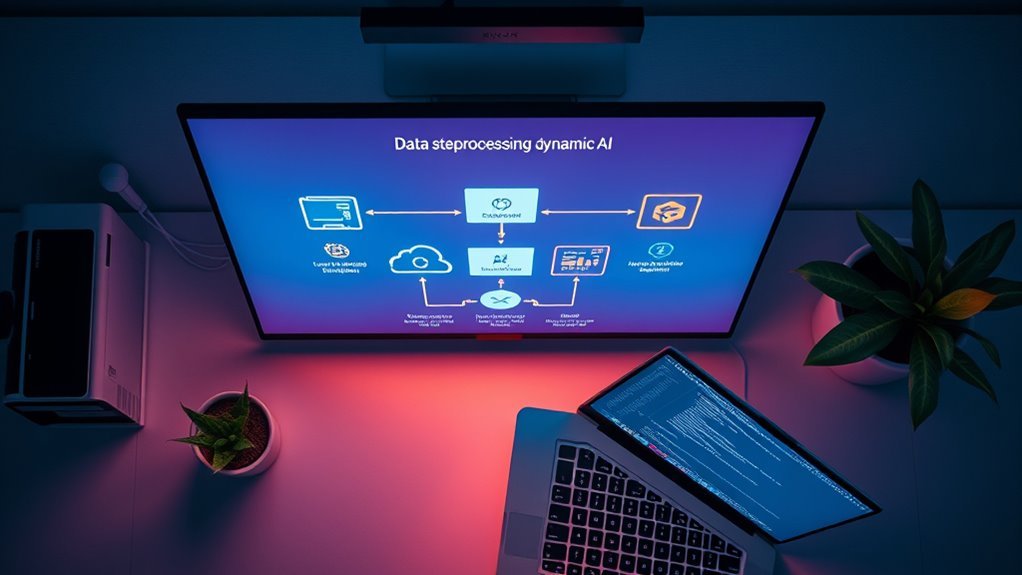You can use AWS Step Functions to orchestrate AI workflows by visually designing state machines that coordinate tasks like data preprocessing, model training, and deployment across AWS services such as Lambda and SageMaker. It automates complex decision paths with built-in error handling and retries, ensuring resilience and scalability. By modularizing your workflow and integrating real-time monitoring, you’ll optimize performance and fault tolerance. Exploring this approach further reveals how to streamline AI pipeline automation effectively.
Understanding AWS Step Functions and Their Role in AI

AWS Step Functions is a serverless orchestration service that lets you coordinate multiple AWS services into scalable AI workflows. In this AWS Step Functions overview, you’ll find that it simplifies workflow automation by visually designing state machines that define your AI processes. You’re empowered to integrate various AI services like Amazon SageMaker, Lambda, and more, enabling seamless AI integration without managing infrastructure. With Step Functions, you automate complex decision-making paths and error handling, granting you the freedom to focus on developing your AI models rather than orchestration logistics. This structured approach provides reliability and scalability, ensuring your AI workflows perform efficiently under varying loads. By mastering AWS Step Functions, you gain the flexibility to build, adjust, and optimize your AI workflows, streamlining deployment and operational control. It also supports integration with Amazon SageMaker, which simplifies the building, training, and deployment of machine learning models.
Designing AI Workflow Architectures With Step Functions

When designing AI workflows with Step Functions, you need to manage states effectively to guarantee smooth task shifts and maintain clarity. Implementing robust error handling strategies is vital to handle exceptions and retries without disrupting the overall process. By structuring your state machine with clear error paths, you can create resilient and maintainable AI pipelines. Leveraging automated workflows enhances efficiency and reduces manual errors in AI workflow orchestration.
Workflow State Management
Although managing the state of complex AI workflows can be challenging, Step Functions provide a structured approach that lets you coordinate multiple services and tasks seamlessly. You gain granular control over workflow state and state changes, ensuring your AI processes execute predictably. To manage workflow state effectively, consider these key strategies:
- Define Clear States: Break down your AI workflow into discrete states that represent logical steps, making changes explicit and easier to maintain.
- Control State Changes: Use Step Functions’ built-in change mechanisms to dictate precise flow control, enabling conditional branching and parallel execution.
- Leverage Input and Output: Pass relevant data between states to maintain context and enable decision-making without external dependencies.
This approach empowers you to build scalable, maintainable AI workflows with transparency and flexibility.
Error Handling Strategies
Since AI workflows often involve multiple interdependent services, you’ll need robust error handling strategies to maintain reliability and minimize downtime. Implementing fault tolerance strategies like retries with exponential backoff and catchers in AWS Step Functions helps you isolate and manage failures gracefully. Effective error propagation techniques guarantee that errors are communicated correctly across workflow states, allowing you to trigger compensating actions or alerts promptly.
| Strategy | Purpose | Implementation Tip |
|---|---|---|
| Retry | Handle transient failures | Use exponential backoff to avoid overload |
| Catch | Capture and redirect errors | Define fallback states to isolate faults |
| Parallel Execution | Improve fault isolation | Run independent tasks concurrently |
These approaches empower you to build resilient AI workflows with minimal disruption.
Integrating Data Preprocessing Steps in Your Workflow

Before building robust AI workflows with AWS Step Functions, you need to assure your data is properly prepared and cleaned. Integrating data preprocessing steps assures your model trains on reliable inputs, maximizing accuracy and efficiency. Here’s how you can structure this:
Proper data preparation and cleaning are essential before building AI workflows with AWS Step Functions.
- Data Cleaning: Automate removal of duplicates, handle missing values, and filter outliers using AWS Lambda or Glue, triggered within your state machine.
- Feature Engineering: Implement transformations and create new features dynamically, leveraging AWS Glue or custom preprocessing scripts orchestrated by Step Functions.
- Data Validation: Incorporate validation checks to confirm data integrity before moving to training, catching issues early and maintaining workflow freedom.
Implementing automated alerts during preprocessing can help detect anomalies in real-time, ensuring issues are addressed promptly before they affect downstream tasks.
Automating Model Training and Hyperparameter Tuning
Once your data is preprocessed and validated, the next step is to automate model training and hyperparameter tuning to optimize performance efficiently. By integrating training automation into your data pipeline, you guarantee consistent execution and scalability. Leveraging AWS Step Functions for cloud orchestration lets you coordinate hyperparameter optimization tasks alongside model evaluation, streamlining workflow efficiency. You can define states that launch training jobs with varied hyperparameters, monitor performance metrics, and dynamically manage resources to prevent bottlenecks. This approach frees you from manual intervention, accelerates experimentation, and adapts resource allocation based on training complexity. Ultimately, automating these processes within a unified workflow empowers you to maximize model quality while maintaining control over resource management and operational overhead. Additionally, utilizing parallelism techniques can significantly accelerate training by distributing workloads across multiple computing resources.
Managing Model Evaluation and Validation Processes
After automating model training and hyperparameter tuning, you’ll need to focus on managing model evaluation and validation to confirm your AI solutions meet desired performance standards. Leveraging AWS Step Functions, you can orchestrate continuous feedback loops and automated assessments that confirm model robustness and data quality.
- Define clear evaluation metrics aligned with business goals to measure model performance accurately.
- Implement validation techniques such as cross-validation and A/B testing within testing frameworks for reliable results.
- Automate iterative assessments to detect data drift and performance degradation, enabling timely model updates.
Incorporating prompt evaluation strategies can further enhance the refinement process by systematically measuring and improving AI outputs.
Deploying AI Models Using Step Functions
You can automate your AI model deployment by orchestrating tasks with AWS Step Functions, ensuring consistent and repeatable workflows. By integrating with AWS services like SageMaker, Lambda, and API Gateway, you streamline the deployment pipeline from training to production. This approach reduces manual intervention and accelerates your model’s time-to-market. Leveraging pipeline parallelism within these workflows can significantly improve the efficiency of model training and deployment processes.
Model Deployment Automation
Although deploying AI models can be complex and error-prone, automating this process with AWS Step Functions simplifies orchestration and improves reliability. You can implement robust model deployment automation by leveraging Step Functions to manage workflows that integrate essential tasks. Here’s how you can structure it:
- Define clear model versioning strategies within your workflow to guarantee traceability and rollback capability.
- Automate continuous delivery pipelines that push validated models to production without manual intervention.
- Incorporate automated testing and monitoring steps to detect deployment issues early and maintain model quality.
Integration With AWS Services
When deploying AI models using AWS Step Functions, seamless integration with other AWS services is essential to streamline workflows and enhance automation. You’ll leverage service orchestration to coordinate AI model training, validation, and deployment tasks across Lambda, SageMaker, and API Gateway. This guarantees efficient workflow coordination and resource optimization. Step Functions’ event-driven architecture enables automatic triggers based on data integration events from S3 or DynamoDB, maintaining service synchronization without manual intervention. You gain fine-grained API management, controlling interactions between services securely and reliably. By adopting these cloud native solutions, you’re free to build scalable, maintainable AI pipelines that adapt dynamically to changing workloads. This integration empowers you to automate complex deployments while maintaining agility and operational control across your AI workflows.
Monitoring and Error Handling in AI Workflows
Since AI workflows often involve complex, multi-step processes, monitoring and error handling become critical to maintaining reliability and performance. You can enhance your system’s fault tolerance and incident response by implementing robust error monitoring and logging strategies. Here’s how to approach it:
- Error Monitoring & Alert Notifications: Set up real-time alert notifications based on error thresholds to quickly identify failures and minimize downtime.
- Retry Policies & Failure Recovery: Define intelligent retry policies within Step Functions to automate failure recovery, reducing manual intervention and maintaining workflow continuity.
- Performance Metrics & Logging: Collect detailed performance metrics and maintain extensive logs to analyze workflow behavior, enabling proactive optimization and root cause analysis.
Leveraging customizable dashboards can help visualize these metrics effectively for faster issue detection and resolution.
Best Practices for Scaling AI Pipelines With Step Functions
Effective monitoring and error handling lay the groundwork for scaling AI pipelines with AWS Step Functions. To build a truly scalable architecture, you should modularize workflows into reusable components, enabling parallel execution and reducing bottlenecks. Leverage Step Functions’ native integration with AWS Lambda and batch processing to optimize pipeline throughput. Implement dynamic state changes and conditional branching to adapt to varying workloads efficiently. Maintain strict version control for your state machines to guarantee smooth rollbacks and iterative improvements. Employ asynchronous invocation patterns when tasks have unpredictable latency, further enhancing pipeline optimization. Finally, use CloudWatch metrics and custom logs to continuously monitor performance and scale resources proactively. Following these best practices grants you the freedom to expand your AI workflows reliably and cost-effectively. Additionally, integrating real-time monitoring helps detect vulnerabilities and performance issues early, ensuring robust pipeline security and stability.



